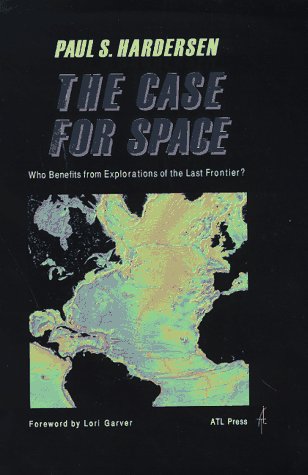atl press scientific pub shrewsbury ma (2 results)
Product Type
- All Product Types
- Books (2)
- Magazines & Periodicals
- Comics
- Sheet Music
- Art, Prints & Posters
- Photographs
- Maps
-
Manuscripts &
Paper Collectibles
Condition
- All Conditions
- New
- Used
Binding
Collectible Attributes
- First Edition
- Signed (1)
- Dust Jacket
- Seller-Supplied Images
- Not Printed On Demand
Seller Location
Seller Rating
-
The Comet Hale-Bopp Book Guide to an Awe-Inspiring Visitor from Deep Space
Published by Atl Press Scientific Pub, Shrewsbury. MA, 1996
ISBN 10: 1882360141ISBN 13: 9781882360147
Seller: Willis Monie-Books, ABAA, Cooperstown, NY, U.S.A.
Book First Edition
Hardcover. Condition: Very Good. Dust Jacket Condition: No Dust Jacket. First Edition. Foreword by Thomas Bopp. ; Frontiers in Astronomy and Earth Science, Vol. 1,; 9.10 X 6.20 X 0.40 inches.
-
The Case for Space : Who Benefits from Explorations of the Last Frontier?
Published by ATL Press, Inc. Scientific Publishers, Shrewsbury, MA, 1997
ISBN 10: 1882360478ISBN 13: 9781882360475
Seller: About Books, Henderson, NV, U.S.A.
Book First Edition Signed
Paperback. Condition: Near Fine condition. Shrewsbury, MA: ATL Press, Inc. Scientific Publishers, 1997. SIGNED by the AUTHOR on the half title page (signature only, NOT personalized to anyone). Near Fine condition. Bright, shiny, clean, and tight. The spine is square and flat with NO creases. Trade Paperback. 6" wide by 9" tall. NO remainder mark. Pages are clean and unmarked. NO underlining. NO highlighting. NO margin notes. Foreword by Lori Garver. From the rear cover: "'Paul Hardersen has written a rare and important book about the exploration of space. While there is plenty of grand vision and high technology here, his book also shows how space technology makes very personal contributions to the quality of life of people around the world. This book shows how individuals can be a part of advancing the space frontier no matter where they are, as Paul invites you to join the great adventure.' -- Scott Pace, Executive Vice President, National Space Society, Chairman, Policy Committee. 'This book is long overdue. Hardersen has marshaled an impressive array of brass-tacks facts documenting the enormous benefits that the space program has brought to the American public. Those skeptical that the expenditures this nation has made in pushing the space frontier are being rewarded by ample economic returns will find in this book necessary medicine. Those already advocating space exploration will find here some of the tools they need to pry open the eyes of even the most closed minded. Read this book and then mail it to your congressman. Hardersen's is a message they need to hear on Capital Hill' -- Dr. Robert Zubrin, Chairman, Executive Committee, National Space Society." From the Publisher: "If you are convinced that Moon rocks, Velcro and Tang represent the sole tangible benefits of spaceflight, you need to read THE CASE FOR SPACE. No mere cheerleader for NASA, Hardersen inspires us with actual examples of space technology at work in our everyday lives. He discusses how space research has already served society and argues that space exploration will advance new technologies, foster international cooperation and spur economic growth. A building catches fire, a siren sounds, and firefighters rush in with oxygen tanks on their backs. They are able to move quickly because their oxygen tanks are made from a lightweight material first used in rocket motor casings! The Martin Marietta Corporation and Structural Composite Industries, Inc. collaborated on this technology, as well as a face mask allowing better visibility and an alarm alerting firefighters when their air supply is running low. A company called Q-Med, Inc. joined with NASA to create a 14-ounce, portable heart monitor that instantly determines whether one's pulse is irregular. The electrodes attached to the patient's chest are the same NASA uses to monitor the pulse of space shuttle astronauts. Hardersen describes the biological lessons of spaceflight, such as the long-term effects of gravity on the human body. A digital imaging firm, started by former NASA employees Kenneth Castleman and Don Winkler, has developed methods to enhance the performance of CAT scanners and radiography systems. The remote sensing capabilities of satellites have revealed the sources of wetland pollution in Florida, the infestation patterns of gypsy moth larvae, and plutonium runoff from nuclear test sites. Hardersen also describes the healthy commercialization of space by private payload-launching firms. While Hardersen shows how the solutions to ozone depletion and energy shortages may depend on today's space policy, he also reports a depressing lack of commitment to space from the United States government and its people. He disproves the delusion that space research is expensive, showing that NASA operates on less than one percent of the total U.S. budget. He blames the White House for not issuing specific goals: 'NASA's lack of direction can be firmly blamed on past and present occupants of the White House and the Congress.' By reading THE CASE FOR SPACE, you may start to realize how much we would all benefit from a renewed commitment to space research.". INSCRIBED / SIGNED by the AUTHOR. 1st ed? (No additional printings listed). Softcover. Near Fine condition. 193pp. 1st ed? (No additional printings listed).



